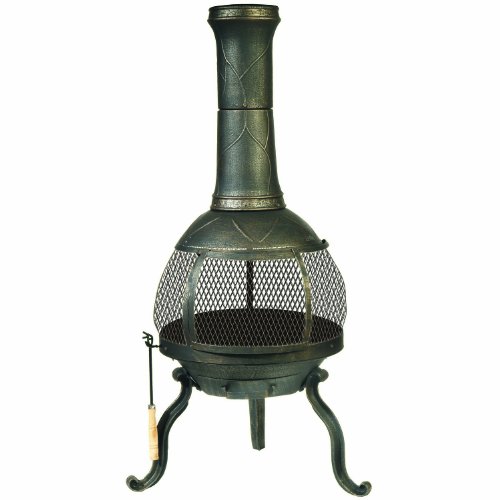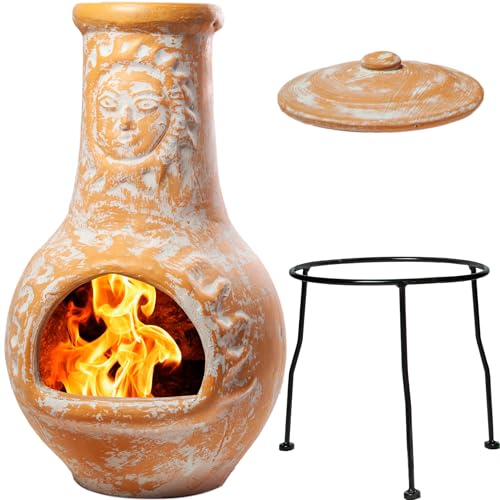10 Things That Your Family Taught You About Chiminea Terracotta
페이지 정보

본문
 A Chiminea Terracotta Adds Warmth and Ambiance to Your Backyard Patio
A Chiminea Terracotta Adds Warmth and Ambiance to Your Backyard Patio A chiminea will add warmth and ambience to your backyard. Its chimney directs smoke upwards to prevent sparks and flames from destroying the surrounding plants and igniting your house or deck.
A chiminea will add warmth and ambience to your backyard. Its chimney directs smoke upwards to prevent sparks and flames from destroying the surrounding plants and igniting your house or deck.Clay chimineas must be seasoned (broken in) slowly. The initial flames should be slow and light. Sealing a chiminea is recommended, especially in rainy climates.
Material
A chiminea can add charm and warmth to any backyard patio. The pot-belly design of the Chiminea is great for entertaining. However, more innovative designs are now available to match different styles of decoration. Although clay is the most popular material, chimineas can be made of aluminum or cast iron. Each type of material has its own benefits. While clay is easy-to-maintain while metal is more durable. It is also able to endure higher temperatures.
Consider the size, design and fuel type when selecting the chimney. The chiminea's size should be able enough to accommodate the amount wood you will use in order to maintain an even flame. The larger chimneys are suitable for large gatherings, while the smaller ones work better in smaller spaces. A chimney is a vent that directs smoke upwards to shield the surrounding area from rain and stopping it from flying around in strong winds.
The design of a chiminea is what distinguishes it from other fire pits that are used outdoors. The bowl-shaped base supports the flames and protects the flames from rain, wind and other debris. The chimney is decorative and allows you to control the size of flames.
Chimineas of clay are formed and molded by hand, then glazed at high temperatures. They're often glazed with ceramic glaze to create a beautiful and durable object to weather damage. Some are decorated in mexican chimineas-inspired patterns. These chimineas can be purchased in home improvement centers.
Before you light the chiminea, cover the interior of the base with coarse-grained sand or gravel. Sand reduces smoke and also prevents the clay from cracking during firing. After you've covered your base, put a few small pieces of sand in the middle. Add a natural fire lighter like this one from Amazon, for easier lighting.
When you're ready to cook, use a long-handled fork or spatula to turn the hot embers. It is not recommended to cook food in direct flames since it could cause burning and cause the food to blacken beyond recognition. Start with a small fire and then build it up slowly. Then, transfer the cooking pan to the top rated chiminea of the smoke stack.
Design
Chimineas look like a potbelly stove with a wide bottom and an extended thin chimney to collect the smoke. The chimney is used to protect the fire against wind and rain which can cause a fire to go out into the open pit. Chimineas have been in use for over four hundred years for gatherings cooking, heating homes and gatherings. They were originally made of clay, they're now offered in cast aluminium chiminea iron or terracotta, with modern and traditional styles.
Modern chimneys are often free of the curvatures of older models, they still retain distinct chimney designs. They are available in a variety of sizes and shapes, ranging from 12 to 16 inches at the base and from 25 to 30 inches tall (including stands). The chimney is typically 6 feet tall.
The height of a chiminea is important because it helps direct smoke upwards, which can keep it from blowing on objects and people in your yard or house. It also lets you use wood that has aromas that smell great as they burn, adding to the pleasure of sitting by a fire.
When choosing a chiminea to purchase choose one that's constructed of a durable material that is able to withstand high temperatures. Avoid models with ornaments or features that may crack or break when heated. If you opt for a clay or terracotta chiminea is to be seasoned, it must be done by burning small amounts of wood for 3 to 4 hours until the clay has a chance to become cured. The chiminea must be secured with a lid when not in use to keep water from spilling over the flames and burning it.
Cast iron chimineas weigh more and more durable than clay models, meaning they are able to withstand higher temperatures and rougher handling. They also offer more versatility, as they can burn coal or briquettes in addition to wood. If you're looking for a classic design, choose the clay chiminea.
Regardless of the material you choose, make sure to place your chiminea inside a fire-proof area away from your home and any outdoor furniture or plants. The chiminea should also be placed at least 10 feet away from any other structures such as fencing or sheds. Create a patio hearth using pavers to create an area to put your chiminea, making it easier to manage the flame.
Installation
A chiminea adds an entirely new dimension to any outdoor space, and is the centerpiece for gatherings with the family. But like any fireplace or fire pit it is crucial to understand the maintenance requirements before purchasing one. Cast iron chimineas are more durable than clay chimineas made of traditional materials. However they require a little different care due to their differences in design.
The first step is to prepare the base of the chiminea. The bottom should be lined with sand gravel, or lava rock to protect it from direct contact with the flame. This will reduce smoke and also prevent the chiminea from breaking.
It is essential to ensure that the chiminea is installed in a secure and stable place. Never put it on a deck or other flammable surface. If you must place it in a place that is flammable, use a metal grates to raise the wood. This will protect the chiminea from heat and sparks of the fire.
It is crucial to season the chiminea before lighting it for the first time. This can be done by burning a number of small fires. This will prevent the chiminea's structure from cracking if you burn lots of wood.
After each fire Clean the chiminea well by brushing it clean with a wire bristle brush, or a dry cloth. You should also remove any ash and creosote within the chiminea. If these chemicals are not removed, they will affect the quality of subsequent fires that you put in it.
The chiminea must be sealed with a protective cover whenever it is not being used. This will prevent the clay from becoming too moist and causing it to shrink and crack. If exposed to snow or rain, chimineas can suffer from this type of damage.
The best way to safeguard the chiminea is to leave it covered, even in the summer. It is also an excellent idea to have an alternative source of fuel for the fire, like a propane tank or wood. It is also a good idea keep a fire extinguisher in the vicinity to get rid of any sudden fires.
Maintenance
To ensure that the chimineas last as long they can, they need regular maintenance. This involves cleaning the structure, applying protective coatings and storing it correctly during winter to avoid extreme temperatures. These measures and basic guidelines for usage can prolong the life of your Chiminea, and also reduce safety hazards.
Chimineas are made from clay, and can crack when exposed to abrupt temperature changes. This is the reason it's essential to store your terra-cotta in a dry and secure location during the off-season, preferably with the cover to guard against rain and frost. It's also recommended to regularly apply a sealant that is protective on your clay chiminea to help shield it from the effects of temperature and moisture.
To avoid damaging the clay surface, use a non-abrasive product and a soft cloth or brush when cleaning a chiminea. After you've scrubbed the surface, rinse it with the help of a hose or bucket. Allow the chiminea to dry completely before reusing it. This will prevent mildew and mold growth and keep it looking brand new.
If your chiminea has cracked section, it's essential to secure the damaged pieces together before applying outdoor oven cement to the crack. It is available at most hardware stores and it is applied using a spatula or pointing trowel. It is important to allow the cement to completely dry before lighting a test fire in the chiminea.
After the cement has dried then sand the ruined area of your chiminea with medium coarse sandpaper to prepare it for repainting. It is then possible to paint it with more than or less any masonry or household emulsion paint in a shade that complements the rest of your chiminea. If the chiminea has corrosion or rust on it take it off by sanding the affected areas, then rinsing them with water to rid them of dust or dirt particles.
- 이전글Warning: These 9 Errors Will Destroy Your Gold News 24.12.19
- 다음글Three Reasons Why The Reasons For Your Rollators For Tall People Is Broken (And How To Repair It) 24.12.19
댓글목록
등록된 댓글이 없습니다.


